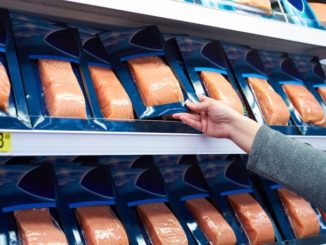You know salmon is good for you—but, some kinds are healthier than others. Here’s how five registered dietitians rate different types of salmon for your health.The health benefits of salmonWhether it tops your sushi roll or your bagel, salmon is one of the healthiest animal proteins you can put on your plate. This fish, loaded with healthy oils, delivers a range of essential nutrients like vitamin D, vitamin B12, and selenium.Also, gram for gram, salmon packs more omega-3 than many of its underwater peers. Why is that a big deal? “Omega-3 fatty acids are essential fatty acids, meaning our body cannot make them, and we rely on [getting them through] our diet,” explains Rebecca Kerkenbush, MS, RD-AP, CSG, CD, FAND, who serves as president of the Wisconsin Academy of Nutrition and Dietetics.The benefits of these so-called “healthy fats” are substantial. Research published in The Journal of Clinical Investigation in 2021 suggests that omega-3s help lower the risk of heart disease.The study found that omega-3 fatty acids appear to trigger molecules that slow or stop inflammation. This may help prevent plaque build-up in our artery walls—a condition known as atherosclerosis.Still, omega-3s play critical roles throughout your body. As for the rest of the nutrients that salmon adds to your meal? Kerkenbush says a serving of salmon includes:protein that’s essential for growth, hormone balance, wound healing, and immune function.vitamin D that supports the immune, brain, and nervous system health while aiding in the body’s calcium absorption for great bones and teeth.B-vitamins that help convert food into energy, promote cell production and growth, and maintain healthy skin and hair.tryptophan, an essential amino acid that helps produce melatonin and serotonin—both which help regulate mood and sleep.How much salmon should I eat?“The [United States Department of Agriculture (USDA)] 2020 Dietary Guidelines recommends that Americans eat at least two to three servings of seafood—including salmon—each week to meet nutrient needs,” says registered dietitian Rima Kleiner, a spokesperson from Dish on Fish, a National Fisheries Institute program. A serving size is typically between three to four ounces, or the size of a checkbook.However, a USDA surveys show that only 10 percent of us are hitting this salmon recommendation. In fact, most people aren’t getting enough omega-3 fatty acids in general.While there’s no official daily intake recommendation set, experts advise that adults consume 250 to 500 milligrams daily—and up to 1,000 milligrams if you have a heart condition.(Feeling hungry? Here are some delicious fish recipes!)Which types of salmon are the healthiest?sergeyryzhov/Getty ImagesAs you’re practicing better omega-3 habits this year, there are some pointers to keep in mind when you’re shopping. “It’s important to differentiate how the salmon is raised to understand the differences nutritionally,” says registered dietitian Natalie Allen, a clinical assistant professor of biomedical sciences at Missouri State University.That’s because diet and habitat influence a fish’s nutritional profile—particularly farm-raised versus caught in the wild. Here’s how this registered dietitian says different types of salmon measure up so you can maximize the health benefits you put in your grocery cart.Wild salmon“Overall, wild salmon is superior nutritionally, but it’s also typically more expensive,” Allen explains. She says that wild varieties tend to have more minerals while farm-raised is higher in vitamin C, calories, and saturated fat—the type of fat we should be limiting in our diets.But the nutrients in fish depend on the waters through which they swim and the food sources they have access to. That’s why, on average, there are slight variations between wild-caught species.Wild Chinook salmonWild-caught chinook salmon, sometimes called “king salmon,” has the highest omega-3 fat content of commercially available species, says Mary Mosquera-Cochran, a registered dietitian at The Ohio State University Wexner Medical Center.This fattiness lends the fish heart-healthy benefits and a moist, buttery taste. But you can also expect a higher price tag compared to other wild species.A 100-gram portion of wild chinook salmon contains:179 calories3.1 grams of saturated fat2255 mg of omega-319.9 grams of proteinIt also packs more than half of our daily value of selenium, a trace mineral that plays an important role in maintaining reproductive health and thyroid function.Wild Sockeye salmon“Out of all the varieties, sockeye salmon is the highest in [vitamin] B12 due to its diet of plankton,” Mosquera-Cochran says.A vitamin B12 deficiency can wreak havoc throughout your body, affecting your heart, nervous system, oral health, and even balance.The deep-red sockeye salmon’s benefits can offer powerful combat against a vitamin B12 deficiency. A serving contains a whopping 130 percent of our daily vitamin B12 requirement, according to the USDA, as well as:153 calories1 gram of saturated fat1060 mg of omega-321.9 grams of proteinResearch published in Marine Drugs also found that sockeye salmon contains high levels of astaxanthin. This antioxidant gives the sockeye salmon its rich red flesh and is thought to protect our body’s nervous system.Wild Coho salmonAlso known as silver salmon, coho salmon are a medium-fatty variety with a milder texture and flavor. Like sockeye and chinook, a serving of wild coho has high levels of vitamin B12 and selenium, as well as:146 calories1.3 grams of saturated fat1317 mg of omega-321.6 grams of proteinWild Pink salmonPink salmon (also called “humpback salmon”) is the most abundant salmon species in the Pacific Ocean, according to the National Oceanic and Atmospheric Association (NOAA.) It’s also the most commercially available option.Pink salmon has a lower oil content that makes for a milder, lighter flavor—and it comes in pouches or cans, says Allen.While slightly lower in healthy fats than its counterparts, pink salmon offers high levels of selenium, vitamin B12, and vitamin B3. Also called niacin, vitamin B3 helps our body produce enough serotonin, a hormone that regulates how our brain cells communicate.A portion of pink salmon also contains:127 calories0.8 grams of saturated fat615 mg of omega-320.5 grams of proteinWild chum salmonWild chum salmon is the second most common variety available and, according to the Alaska Department of Fish and Game, it’s most often sold in cans or as smoked salmon products.It has lower fat content like pink salmon than other wild-caught species, which lends chum salmon its light, flaky texture. But a serving still far exceeds the amount of omega-3s experts recommend we get each day.A serving of wild chum salmon contains:120 calories0.84 grams of saturated fat706 mg of omega-320.1 grams of proteinFarmed salmon“Wild salmon swim between freshwater and the ocean consuming a natural diet of zooplankton and smaller fish,” says Alissa Rumsey, a Brooklyn-based dietitian and the author of Unapologetic Eating.But farmed salmon are typically raised in pens and fed fishmeal, fish oil, and other proteins that aren’t a part of their traditional diet in the wild. That’s why in general, wild-caught seafood species are more nutritious than their farmed counterparts.Still, most people aren’t getting enough servings of seafood to begin with, says registered dietitian nutritionist Lauren Moller-Seat at the University of Maryland St. Joseph Medical Center. “So, if you’re able, eating any type of salmon is better than nothing.”Atlantic salmonAtlantic salmon make up about 90 percent of the farmed salmon market, according to the Food and Agriculture Organization (FAO.) This is because it’s a protected species—so commercial fishing for Atlantic salmon is prohibited.While farmed Atlantic salmon tends to skew higher in calories and saturated fats than wild varieties, it also has very high omega-3 levels. According to the USDA, a 100-gram portion contains:208 calories3.05 grams of saturated fat2503 grams of omega-320.4 grams of proteinDoes eating salmon have any risks?mixetto/Getty ImagesWhether swimming in the wild or a farm environment, studies show that all types of salmon ingest some level of contaminants that can get passed onto our plate.However, an analysis published in the Journal of Nutrition suggests that the risk of contaminant exposure when eating salmon is offset by the benefits of getting enough omega-3s in our diet.That said, farmed salmon can contain certain pollutants, particularly polychlorinated biphenyls (PCBs.) These contaminants are associated with cancer and other health problems, Rumsey says.“With that in mind, wild fish may have more access to eating smaller fish that have ingested plastic pieces—and their chemicals—that are floating in the ocean,” adds Dana Hunnes, PhD, a senior dietitian at UCLA Medical Center.And more recent research indicates the levels of PCBs in farmed fish are in decline. A 2003 study conducted by the Environmental Working Group found PCB content five to 10 times greater in farmed fish than wild fish.Yet a 2020 study published in the journal Foods found that farmed Atlantic salmon actually had lower contaminant levels than its wild counterpart—suggesting an improvement in aquaculture practices and regulations over the last two decades.Salmon comes with a low mercury risk as well. “While larger fish like tuna or swordfish can be high in mercury, salmon, fortunately, doesn’t have that mercury build-up, so it continues to be a great seafood option,” Moller-Seat says.In fact, a joint report from the World Health Organization (WHO) and the FAO says that today, the most significant risk of eating seafood like salmon is not eating enough.How do I shop for different types of salmon?Rumsey recommends looking for salmon that originates out of Alaska, as the state adheres to strict sustainability standards.Beyond that, here’s what else to look for: “The most environmentally friendly salmon would be those that are wild and caught with a line-and-pole method,” Hunnes adds. Overfishing via industrial fishing methods contributes to population declines—and can threaten endangered or vulnerable species that get caught as bycatch.Seafoodwatch.org is a great resource to help you navigate which types of fish are most sustainable and safe.But from there, does it matter how you eat your salmon?Canned salmonThe exact nutritional content of a can of salmon will depend on its other ingredients—like if the fish is in water or oil and if there’s added salt. “But in general, canned salmon is just as nutritious as any other wild salmon,” Rumsey says. “And sometimes even more so.”For example, she says that canned salmon can contain higher calcium levels because the canning process softens the fish’s bones, so they’re edible.Smoked salmonAlexander Spatari/Getty ImagesOther forms of preserved salmon—like dried, cured, or smoked—can have higher concentrations of nutrients like vitamins and minerals than the fresh fish. At the same time, the macronutrients like fats stay the same, says Emily Clairmont, a registered dietitian with the University of Vermont’s Professional and Continuing Education.But there’s a catch. A serving of smoked salmon can contain almost a third of our daily recommended amount of sodium, according to the USDA.Raw or cooked?“Sushi-grade salmon has no regulation in the US,” Clairmont says. So if you’re looking to buy salmon to eat raw as sushi or sashimi, you want to make sure you work with a reputable fishmonger to ensure you’re getting a fresh, high quality, and safe product that’s free of dangerous parasites.Still, aside from personal preference, there’s not much benefit to eating salmon raw instead of cooked. “Cooking does not greatly alter the nutrition of salmon,” Allen says.The exception? Make sure to avoid frying or deep-frying your salmon, as this will increase its fat content and might burn off some nutrients. In fact, a study published in The Journal of Steroid Biochemistry and Molecular Biology found that fried salmon lost around 50 percent of its vitamin D content—whereas baked salmon lost none.Fresh or frozen salmon?While there aren’t studies comparing fresh and frozen salmon specifically, Clairmont says both are great options. “Based on the research of other frozen animal-based proteins, it’s assumed that there would be little to no difference nutritionally between fresh or frozen salmon filet.”Quality doesn’t suffer, either. Researchers at Oregon State University found that in blind taste tests, frozen salmon (and other fish) actually outperformed fresh options.Next, read what fish-eaters need to know about mercury in fish. And, if you’re looking to upgrade your wellness game this year, read 10 Easy Self-Care Swaps to Make in 2022. […]








